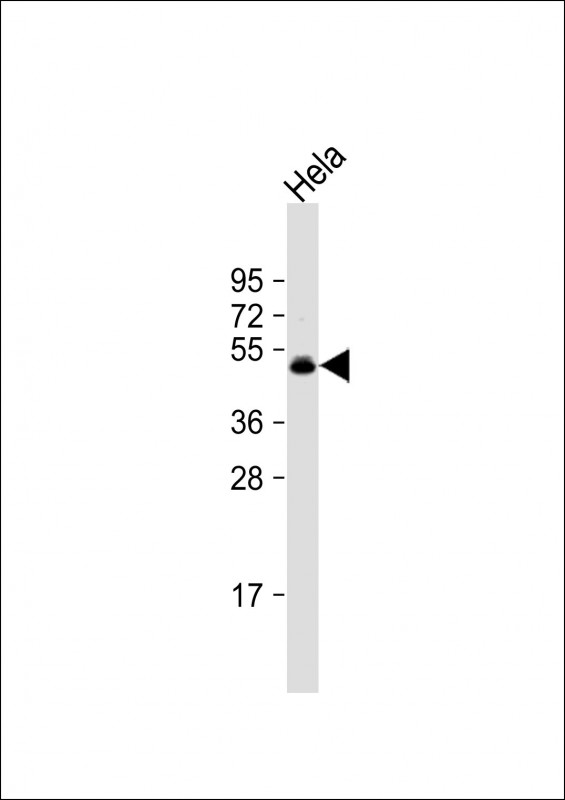CEPT1 Antibody (N-term)
Affinity Purified Rabbit Polyclonal Antibody (Pab)
- SPECIFICATION
- CITATIONS: 2
- PROTOCOLS
- BACKGROUND

Application
| IHC-P-Leica, WB, E |
|---|---|
| Primary Accession | Q9Y6K0 |
| Other Accession | Q7ZYQ3, Q6AXM5, Q8BGS7, NP_001007795.1, NP_006081.1 |
| Reactivity | Human, Mouse |
| Predicted | Rat, Xenopus |
| Host | Rabbit |
| Clonality | Polyclonal |
| Isotype | Rabbit IgG |
| Calculated MW | 46554 Da |
| Antigen Region | 29-57 aa |
| Gene ID | 10390 |
|---|---|
| Other Names | Choline/ethanolaminephosphotransferase 1, hCEPT1, CEPT1 |
| Target/Specificity | This CEPT1 antibody is generated from rabbits immunized with a KLH conjugated synthetic peptide between 29-57 amino acids from the N-terminal region of human CEPT1. |
| Dilution | WB~~1:2000 IHC-P-Leica~~1:500 |
| Format | Purified polyclonal antibody supplied in PBS with 0.09% (W/V) sodium azide. This antibody is purified through a protein A column, followed by peptide affinity purification. |
| Storage | Maintain refrigerated at 2-8°C for up to 2 weeks. For long term storage store at -20°C in small aliquots to prevent freeze-thaw cycles. |
| Precautions | CEPT1 Antibody (N-term) is for research use only and not for use in diagnostic or therapeutic procedures. |
| Name | CEPT1 {ECO:0000303|PubMed:12216837, ECO:0000312|HGNC:HGNC:24289} |
|---|---|
| Function | Catalyzes both phosphatidylcholine and phosphatidylethanolamine biosynthesis from CDP-choline and CDP- ethanolamine, respectively (PubMed:10191259, PubMed:10893425, PubMed:12216837, PubMed:37137909). Involved in protein-dependent process of phospholipid transport to distribute phosphatidyl choline to the lumenal surface (PubMed:10191259, PubMed:10893425, PubMed:12216837). Has a higher cholinephosphotransferase activity than ethanolaminephosphotransferase activity (PubMed:10191259, PubMed:12216837). |
| Cellular Location | Endoplasmic reticulum membrane; Multi-pass membrane protein. Nucleus membrane; Multi-pass membrane protein |
| Tissue Location | Ubiquitously expressed. |

Provided below are standard protocols that you may find useful for product applications.
Background
Cholinephosphotransferase catalyses the final step in the synthesis of phosphatidylcholine by the transfer of phosphocholine from CDP-choline to diacylglycerol. The synthesis of phosphatidylethanolamine by ethanolaminephosphotransferase occurs using an analogous reaction. This gene codes for a choline/ethanolaminephosphotransferase. The protein can synthesize either choline- or ethanolamine- containing phospholipids. Two alternatively spliced transcripts encoding the same isoform have been identified.
References
Rose, J.E., et al. Mol. Med. 16 (7-8), 247-253 (2010) :
Lamesch, P., et al. Genomics 89(3):307-315(2007)
Wright, M.M., et al. Lipids 37(7):663-672(2002)
Henneberry, A.L., et al. Biochem. J. 339 (PT 2), 291-298 (1999) :
If you have used an Abcepta product and would like to share how it has performed, please click on the "Submit Review" button and provide the requested information. Our staff will examine and post your review and contact you if needed.
If you have any additional inquiries please email technical services at tech@abcepta.com.














 Foundational characteristics of cancer include proliferation, angiogenesis, migration, evasion of apoptosis, and cellular immortality. Find key markers for these cellular processes and antibodies to detect them.
Foundational characteristics of cancer include proliferation, angiogenesis, migration, evasion of apoptosis, and cellular immortality. Find key markers for these cellular processes and antibodies to detect them. The SUMOplot™ Analysis Program predicts and scores sumoylation sites in your protein. SUMOylation is a post-translational modification involved in various cellular processes, such as nuclear-cytosolic transport, transcriptional regulation, apoptosis, protein stability, response to stress, and progression through the cell cycle.
The SUMOplot™ Analysis Program predicts and scores sumoylation sites in your protein. SUMOylation is a post-translational modification involved in various cellular processes, such as nuclear-cytosolic transport, transcriptional regulation, apoptosis, protein stability, response to stress, and progression through the cell cycle. The Autophagy Receptor Motif Plotter predicts and scores autophagy receptor binding sites in your protein. Identifying proteins connected to this pathway is critical to understanding the role of autophagy in physiological as well as pathological processes such as development, differentiation, neurodegenerative diseases, stress, infection, and cancer.
The Autophagy Receptor Motif Plotter predicts and scores autophagy receptor binding sites in your protein. Identifying proteins connected to this pathway is critical to understanding the role of autophagy in physiological as well as pathological processes such as development, differentiation, neurodegenerative diseases, stress, infection, and cancer.





